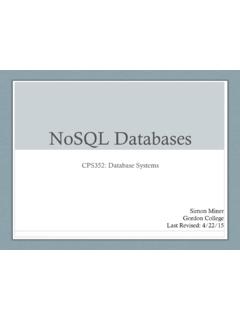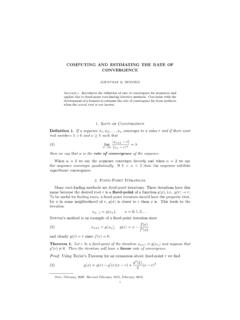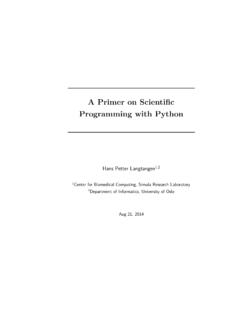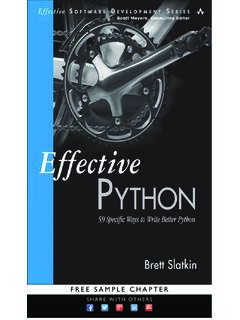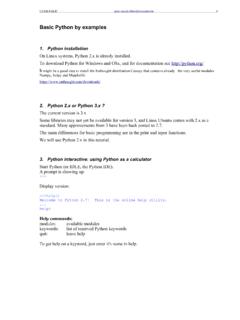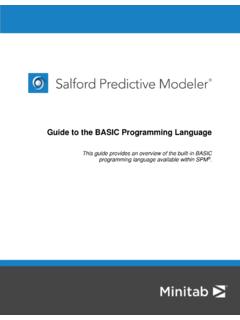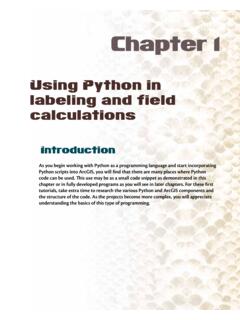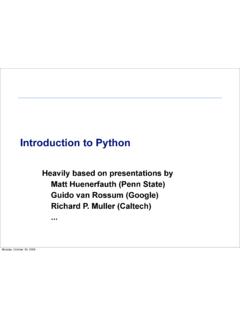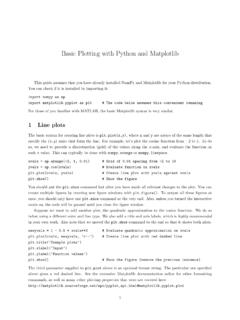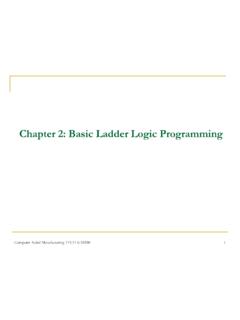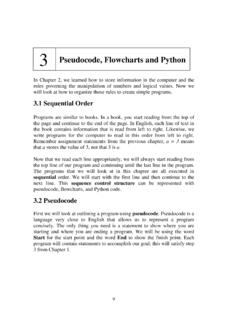Transcription of A Comparison of the Syntax of Python and Java
1 PythonPython supports many (but not all) aspects of object-oriented programming; but it is possible to write a Python program without making any use of OO concepts. Python is designed to be used interpretively. A Python statement may be entered at the interpreter prompt (>>>), and will be executed immediately. (Implementations make some use of automatic compilation into bytecodes (.pyc files). Python is dynamically typed: A variable is introduced by assigning a value to it. example :someVariable = 42 A variable that has been assigned a value of a given type may later be assigned a value of a different type. example :someVariable = 42someVariable = 'Hello, world' Python supports the following built-in data types: Plain integers (normally 32-bit integers in the range -2147483648 through 2147483647).)
2 Long integers (size limited only by memory size of the machine running on) Booleans (False and True). Real numbers. Complex addition, Python supports a number of types that represent a collection of values - including strings, lists, and dictionaries. JavaJava supports only object-oriented programming. Programs written in Java must be explicitly compiled into bytecodes (.class files), though an IDE may do this automatically in a way that is transparent to the user. Java does not support direct execution of statements - though there are tools like Dr. Java that support is statically typed: A variable must be explicitly declared to be of some type before assigning a value to it, though declaration and assignment may be done at the same time. Examples:int someVariable;int someVariable = 42; A variable that has been declared to be of a particular type may not be assigned a value of a different has two kinds of data types: primitive types and reference types.
3 Java supports the following primitive data types: byte - 8-bit integers short - 16-bit integers int - 32-bit integers long - 64-bit integers (Java also supports a class to represent integers whose size is limited only by memory) float - 32-bit real numbers. double - 32-bit real numbers. boolean - (false and true). char - a single addition, Java supports arrays of any type as the reference types, and the API includes the class String and a large number of classes used for collections of values. A Comparison of the Basic Syntax of Python and Java1 Python is line-oriented: statements end at the end of a line unless the line break is explicitly escaped with \. There is no way to put more than one statement on a single line. Examples:this is a statementthis is another statementthis is a long statement that extends over more \ than one linePython comments begin with # and extend to the end of the line.
4 example :# This is a commentA new statement starts herePython strings can be enclosed in either single or double quotes (' or ""). A character is represented by a string of length 1. Examples:'This is a string'"This is also a string" # Equivalent'c' # A string"c" # An equivalent stringPython uses the following operators for constructing compound boolean expressions: and, or and not. example :not(x > 0 and y > 0) or z > 0In Python , the Comparison operators (>, <, >=, <=, == and !=) can be applied to numbers, strings, and other types of objects), and compare values in some appropriate way ( numeric order, lexical order) where in Java always end with a semicolon (;). It is possible for a statement to run over more than one line, or to have multiple statements on a single line.
5 Examples:this is a statement;this is another statement;this is a long statement that extends over more than one line;a statement; another; another;Java has two kinds of comments. A comment beginning with // extend to the end of the line (like Python comments). Comments can also begin with /* and end with */. These can extend over multiple lines or be embedded within a single line. Examples:// This is a commentA new statement starts here/* This is also a comment *//* And this is also a comment, which is long enough to require several lines to say it. */Statement starts /* comment */ then continuesJava strings must be enclosed in double quotes (""). A character is a different type of object and is enclosed in single quotes ('). Examples:"This is a String"'c' // A character, but not a StringJava uses the following operators for constructing compound boolean expressions: &&, ||, !
6 And ^ (meaning exclusive or) example :! (x > 0 && y > 0) || z > 0 ^ w > 0In Java, most of the Comparison operators ( >, <, >=, and <=) can be applied only to primitive types. Two (== and !=) can be applied to any object, but when applied to reference types they test for same (different) object rather than same (different) Comparison of the Basic Syntax of Python and Java2 There is no universally-accepted Python convention for naming classes, variables, functions etc. Python definite looping statements have the form for variable in expression: example :for p in pixels: somethingPython uses the built-in function range() with for to loop over a range of integers. Examples:for i in range(1, 10) something(i takes on values 1, 2, 3, 4, 5, 6, 7, 8, 9)for i in range(1, 10, 2) something(i takes on values 1, 3, 5, 7, 9) Python indefinite looping statements have the form while condition: example :while x > 0: something By convention, most names in Java use mixed case.
7 Class names begin with an uppercase letter; variable and function names begin with a lowercase letter. Class constants are named using all uppercase letters with underscores. Examples:AClassNameaVariableNameaFunctio nName()A_CLASS_CONSTANTJava has two kinds of definite looping statements. One has the form for (variable in collection) example :for (p in pixels) something;Java uses a different form of the for to loop over a range of integers. Examples:for (int i = 1; i < 10; i ++) something;(i takes on values 1, 2, 3, 4, 5, 6, 7, 8, 9)for (int i = 1; i < 10; i += 2) something;(i takes on values 1, 3, 5, 7, 9)Java has two forms of indefinite looping statement. One has the form while (condition) example :while (x > 0) something;The other has the form do .. while(condition).
8 example :do something; while(x > 0);A Comparison of the Basic Syntax of Python and Java3 Python conditional statements have the form if condition: and an optional else part has the form else:. The form elif condition: is allowed as an alternative to an else: immediately followed by an if. Examples:if x < 0: somethingif x < 0: somethingelse: something differentif x < 0: somethingelif x > 0: something differentelse: yet another thingJava conditional statements have the form if (condition) and an optional else part has the form else (no colon) There is no elif form - else if is used directly. Examples:if (x < 0) something;if (x < 0) something;else something different;if (x < 0) something;else if (x > 0) something different;else yet another thing;Java also has another form of conditional statement (switch) which has no analog in Python .
9 example :switch(i){ case 0: something 1; something 2; .. break; case 1: something else; break; .. default: yet something else;}(The individual cases can include any number of statements [ shown for the first case only, but possible for any ], normally ending with the special statement break; )A Comparison of the Basic Syntax of Python and Java4 The scope of a Python conditional or looping statement is denoted by indentation. (If multiple lines are to be included, care must be used to be sure every line is indented identically). Examples:if x < 0: do somethingdo another thing regardless of the value of xif x < 0: do something do something else do yet a third thingdo another thing regardless of the value of xThe scope of a Java conditional or looping statement is normally just the next statement.
10 Indentation is ignored by the compiler (though stylistically it is still highly desirable for the benefit of a human reader). If multiple lines are to be included, the scope must be delimited by curly braces ({ , }). (Optionally, these can be used even if the scope is a single line.) Examples:if (x < 0) do something;do another thing regardless of the value of x;if (x < 0)do something; // Bad style-don't do this!do another thing regardless of the value of x;if (x < 0){ do something; do something else; do yet a third thing;}do another thing regardless of the value of x;if (x < 0){ do something;}do another thing regardless of the value of x;A Comparison of the Basic Syntax of Python and Java5A Python function definition has the form def function-name(formal-parameter-list): bodyExample:def disc(a, b, c): return b * b - 4 * a * c If there are no parameters, an empty list (()) is used.
